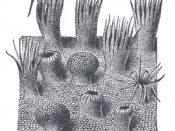Some taste buds can sense one taste, but others can sense more than one.
Scientist have tried to categorize taste by molecule size and shape, by weight ,by the kind of electrical charge the molecule may carry, other characteristics, but they have not yet found a rule to explain what attributes a molecule must posses to make it taste a certain way.
Nobody knows what happens when a molecule touches a taste hair that makes the taste cell react to it, it's an unsolved mystery.
There's a African country of Ghana, where the people eat this plant called syncipalium mirabilis in the morning because it makes the food sweeter the rest of the day.
From nerves at the bottom of the taste cells, tatse impulses travel to two principle nerves, called the lingual nerve and the chorda tympani, they also carry sensations of temperature ,touch, and pain from the tongue.
The sensaions travel along the main nerves to the medulla, at the very top of the spinal cord, in the brain stem.
The information from the sense of smell that is active before and during eating, travels through the limbic system to the cortex.
Smell takes about 25,000 times more of a substance to activate the sense of taste than it does to trigger the sense of smell.
The brain makes judgements about this experience deciding if the food is good or bad.
Taste tends to become less sensitive as people age because, after age 45, some taste cells die and are not replaced. A cold can also temporarily keep people from tasting their food, mostly because they can't smell it. At any age injury to the brain nerves, or tongue can cause the permanent loss of taste and smelling abilities.
A desire to eat non-food things such as ice,


